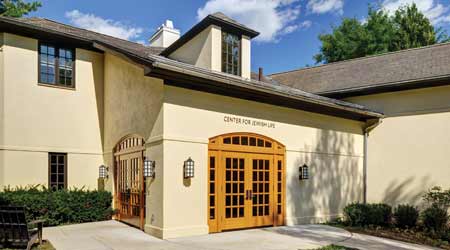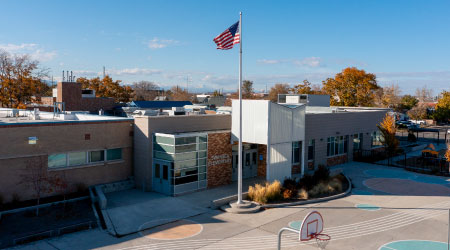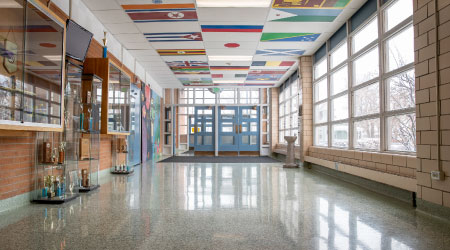 The renovation of the facility housing the Princeton University Center for Jewish Life included upgrades to mechanical systems and building envelope to contribute to the project’s long-term resilience and energy efficiency.Photo by Michael Slack, courtesy JZA+D
The renovation of the facility housing the Princeton University Center for Jewish Life included upgrades to mechanical systems and building envelope to contribute to the project’s long-term resilience and energy efficiency.Photo by Michael Slack, courtesy JZA+DHow to Plan for Long-Term Campus Resilience
Resilience can't be a one-and-done idea: FMs need to address a variety of vulnerabilities and constantly revamp plans to achieve long-term resilience.
Colleges and universities are increasingly factoring in the need to provide power in the event of a utility outage. The Harvard University sustainability project incorporates a state-of-the-art district energy facility for its Allston campus. Designed to be highly efficient with low-carbon output, the district energy facility also represents forward thinking about climate resilience. The university moved the district energy facility to an above-grade location. What’s more, the facility will use low-temperature hot water to transfer heat energy, rather than relying on steam distribution. This approach will make the facility better able to handle any flooding that might occur. In addition, using low-temperature hot water is more efficient and enables the facility to use waste heat from a wider variety of sources, according to the university.
The lessons from this major, ongoing effort are enormously valuable. But most colleges and universities have limited resources compared to Harvard’s, and most have no way to install a permanent generator for backup power.
Alternative approaches to keeping the lights on are needed. One such solution is to add industrial-sized receptacles for an emergency generator to be added later if and when it is needed. These are easy to add to new buildings, and existing facilities may find that a retrofit is cost-effective. The plug-and-play simplicity makes coping with power outages more manageable, because the switch-rated connections reduce downtime significantly.
Facility managers should also consider how moisture will be managed in the event that water gets into a building. Some amount of flooding may be unavoidable, especially for existing facilities on older campuses. Preparation that can decrease response time and mitigate damage is therefore crucial. If a building is to remain operable, it must continue to be healthy for its occupants to use, and where the aftermath of flooding is concerned that means keeping mold and rot — sources of contaminants in the air — at bay.
Landscaping and other strategies provide the first line of defense and may direct enough surface water away from buildings to avoid serious damage. Facilities teams should also investigate the structure’s envelope and ventilation strategy. Incorporating air, moisture, and vapor barriers into enclosures will help to prevent the degradation of drywall and plywood while reducing the likelihood of mold and rot. Likewise, proper circulation of air can help reduce flood-related moisture before mold and similar contaminants can gain a foothold.
Addressing other risks
Flood is not the only threat to campus facilities and operations. The greater threat in arid regions is typically from wildfire, while in mountainous areas the more significant risk may be from landslide, mudslide, or avalanche. Still other campuses may be more likely to be damaged by high-force winds and tornados, and accompanying wind-borne debris.
Proper siting can reduce the likelihood of a building being damaged by landslide or catching fire, if the site is an effective distance from the source, taking wind patterns (in the case of fire) and topography into careful account. Proper orientation of a structure could reduce damage from debris in some cases. For example, an analysis of weather patterns might indicate that debris is more likely to strike the new building from certain directions, so the design could locate most windows on opposing elevations. And landscaping can present barriers against mud or rockslide, or to slow the progress of fire.
Other architectural solutions may be brought to bear as well, such as fire-resistant façade systems and impact-resistant glass. Most of these solutions could be considered for both new construction and retrofit approaches.
Resilience for the long term
Leading institutions that are making changes and improving plans for resilient facilities and campuses are doing more than just staving off temporary crises. These investments have long-term payoffs built in. Properties that perform better ensure fewer and shorter interruptions to academic life and economic activity on campus, effectively increasing the value of the facilities portfolio. Combined with efficient and sustainable energy and water strategies, resilience efforts can reduce operational and maintenance costs in addition to reducing (or avoiding entirely) the costs of responding to a catastrophic event. Insurance premiums may be significantly lowered, too.
For these reasons, it’s essential that all institutions of higher education undertake resilience-oriented master planning initiatives as soon as possible, instead of waiting for the inevitable crisis or natural disaster to spur the administration to action. That said, the experience gained from recent major events offers important data for planning.
Mark Sullivan (msullivan@joshuazinder.com), AIA, NCARB, LEED AP, is an architect and partner with integrated design firm JZA+D.
Related Topics:














